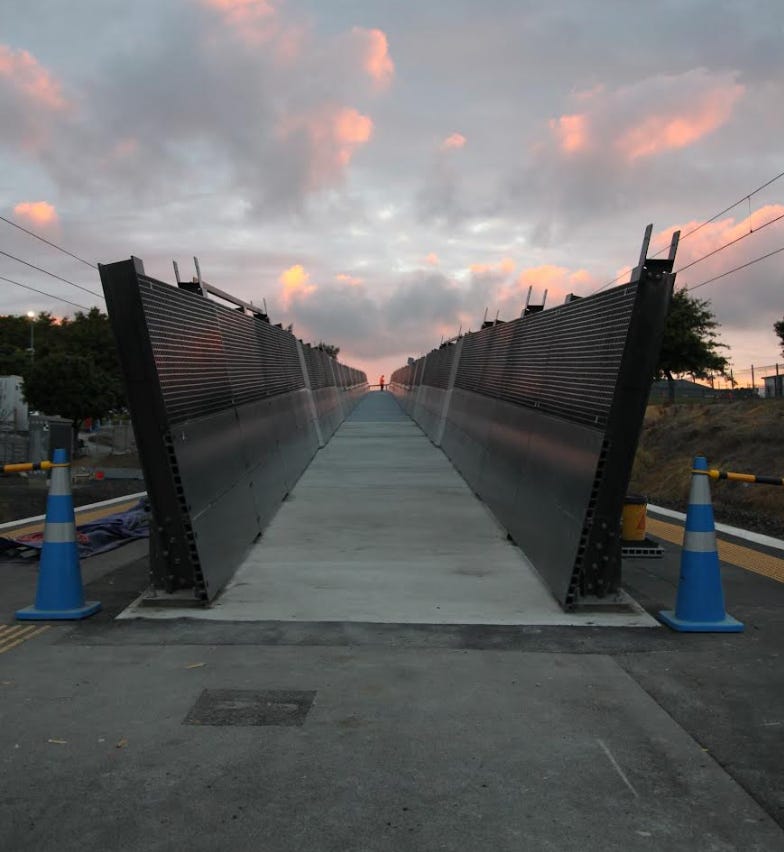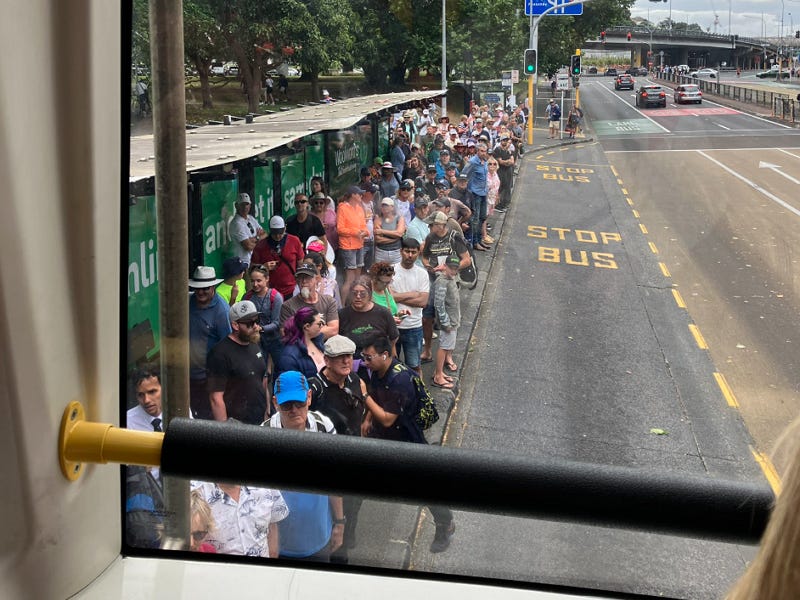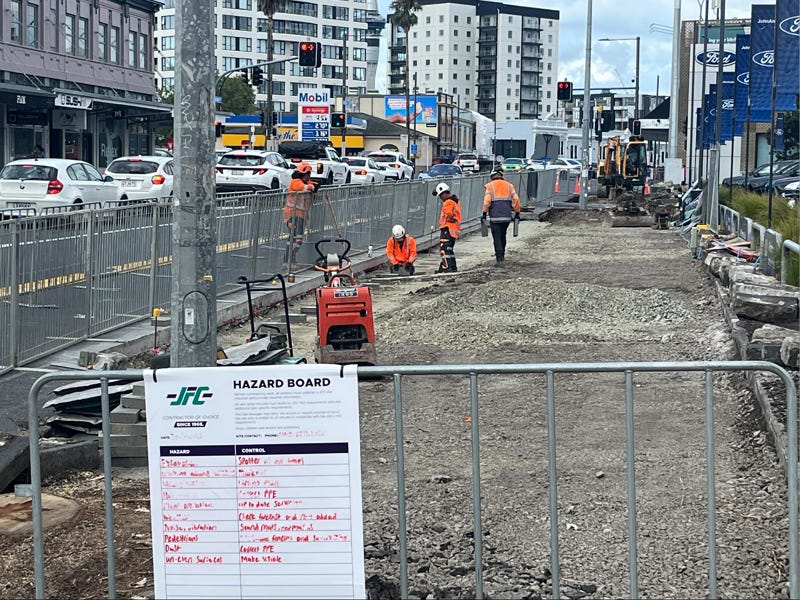It's Friday and we've got Auckland Anniversary weekend ahead of us so we've pulled together a bumper crop of things that caught our attention this week.
This week in Greater Auckland
On Monday, following a cabinet reshuffle resulting in us having a new Minister of Transport, Connor asked if we can have a normal one now.
On Wednesday Matt looked at growth in Auckland following an article asking how big can Auckland get.
Million Milestone
Auckland Transport announced this week that a million trips had been made on public transport using contactless payments.
Yesterday at precisely 3.56pm, an unsuspecting passenger made history when they hopped off a route 27H bus by the Grafton Bridge after a short trip up Symonds Street.
As the passenger tagged off the bus, that one small tap of a phone, smart watch, credit or debit card marked the end of the millionth journey made using contactless payments in Auckland since new ways to pay were introduced in November last year.
We will never know who that passenger was, but what we do know is that passenger made history in their own little way yesterday – so thanks a million!
Auckland Transport (AT) Chief Executive Dean Kimpton says reaching one million trips is a tremendous milestone for Auckland’s public transport and one that was reached weeks earlier than originally expected.
.....
Auckland’s big weekend of events helped to push up the number of customers using contactless payments further, Mr Kimpton says.
“With visitors in the city for Luke Combs, SailGP and the Auckland FC match on Saturday we experienced the biggest day so far for contactless payments, with 13 per cent of customers making the most of AT’s new ways to pay.
“AT’s roll-out of contactless payments was a real highlight of 2024, but we’ve got even more to look forward to with public transport this year.”
“With trains returning to Pukekohe next month following the electrification of the line from Papakura, a fleet of brand new double decker electric buses taking over the WX1 route from April, and our first electric ferries hitting the water this year there’s a lot to look forward to."
Rail work almost over
This long weekend represents the last full weekend of the rail network being closed and it will be great to start getting trains back next week - though some parts of the southern and eastern lines between Otahuhu and Homai will remain closed till the following week.
One of the projects completed over the last few weeks has been the removal of pedestrian level crossings at Homai and the replacement of the stairs down from Browns Rd with a ramp.
Homai Station is now ready for more frequent train services when the City Rail Link opens in 2026, with safer access to the station as well as improvements for the local blind and low vision community.
The safer access replaces two pedestrian level crossings which are now closed as part of an ongoing programme replacing level crossings to support more frequent trains while improving safety and keeping roads moving.
A ramp is a much better experience than lifts, much cheaper and more reliable too.
Ferry Good
On the weekend a video emerged of an Auckland ferry sailing through a practice session for SailGP. Paddy Gower wrote gets it right
I have a simple message for the ferry skipper who just sailed on through the SailGP at the weekend.
You bloody legend.
The vision has gone viral globally - the ferry is making its way across the harbour and ain’t nothing gonna stop it.
Not even a whole lot of very fast and very expensive boats racing at nearly 100km/h.
The skipper didn’t care about the millions of eyeballs on the racing. The skipper didn’t care about the fancy technology on the boats and their flash blimmin’ foils and all the flash athletes on board.
What the skipper did care about was the 20 or so punters who’d paid good money - $6 - to get into Auckland on goddamn time.
.....
The skipper gave us another important message: public transport must get to its destination on time.
So don’t criticise them. It’s hard enough to get around Auckland as it is.
What the skipper showed us was that priorities matter.
Meanwhile now retired journalist Todd Niall noted that it seems AT was just running a standard bus schedule resulting in this at Victoria Park.
Climate Inaction will cost more
BusinessDesk's Dileepa Fonseka has a good piece reminding that climate inaction will cost more than doing something.
Climate change inaction will likely cost New Zealand more than action ever will.
I mention this because, in recent months, it has seemed like “NZ Inc” has been moving ever closer to the idea that undermining the global push towards climate change will be a profitable endeavour for us.
This month's Los Angeles County fires and the words of the people buying our most valuable exports show this is a dangerous economic delusion.
.....
And while it would be tempting to think climate change is an issue that voters don’t care about, it is still viewed as more important than unemployment, according to Ipsos.
It is also within the top eight issues of concern identified by people surveyed in the Ipsos issues monitor poll.
Combatting climate change will undoubtedly involve costs, but failing to act risks even greater economic losses – rising insurance premiums, eroding export markets, and diminished global standing.
For NZ, inaction is not just risky, it’s costly.
Auckland's Infrastructure Advantage
In another interesting piece from Business Desk, Oli Lewis reports on how Auckland's competitive advantage to infrastructure.
Auckland has a competitive advantage when it comes to infrastructure provision, with its larger and denser population allowing costs to be spread between more people.
That’s one of the takeaways of new research from the Infrastructure Commission, which released a report last week about infrastructure in the super city.
The commission, Te Waihanga, found the cost of rolling out ultra-fast broadband in Auckland, for example, was 13% cheaper than the rest of New Zealand.
Electricity prices in Auckland Central were also 5% lower than the national average over the past five years, the report said.
In an interview with BusinessDesk, commission chief executive Geoff Cooper said: “What we’re trying to do with this report is say the costs of infrastructure should be an input for planning purposes – that we should actively try and grow the areas that are cheapest to service with infrastructure because that means we’re going to be able to build more hospitals and more schools, and other things.”
Slower speeds and cheaper insurance
Some interesting reporting out of the UK.
They have proved hugely controversial, but 20mph speed limits appear to be making car insurance cheaper.
This week a leading price comparison website reported the biggest annual drop in UK car insurance prices in more than 10 years, with the average cost of cover falling by £161 – or 16% – in the past 12 months.
.....
While some of this fall has been attributed to renewed competition between insurers and improvements to safety features in vehicles, the chief executive of Confused.com, Steve Dukes, also points to the speed control zones that have been introduced in many areas.
“Some UK insurers are observing that areas where 20mph zones have been introduced result in lower levels of claim frequency – a key factor in the cost of car insurance,” he says.
“Though many drivers find these reduced speed zones frustrating, it’s positive to see the bright spot this is creating for drivers’ costs.”
.....
The first indications that 20mph zones could bring down the cost of car insurance – as well as cutting speeds and reducing road casualties – came in June last year, when the car insurer esure reported that vehicle damage claims in Wales fell by a fifth after the default limit was introduced.
The company said at the time that the speed restriction was “clearly having an impact”,” and it later said that the average driver could be looking at a £50-a-year saving on their motor insurance if the zones were rolled out across UK towns and cities.
Gt North Rd Upgrade has finally started
Pippa Coom has a fantastic piece on the Gt North Rd starting and some of the wider implications of it in the Spinoff.
A roadside karakia blessing last Monday marked the official start of the long-delayed Great North Road improvement project . For many of us assembled at dawn, the overwhelming emotion was relief that the wrangling was finally over. After years of delay, Aucklanders are getting an exemplary design that delivers multiple upgrades for the price of one. Even better, it tackles head-on the various grumbles floating around regarding transport in Auckland, by leveraging existing budgets to get bang for AT’s buck while delivering a project which is what the community actually wants.
And yet, the mayor wasn’t there at the photo op to wish Great North Road well. Why not? To explain that, we need to zoom out. The mayor ended 2024 on a high note by delivering on his campaign promise of “Auckland taking back control”. Transport minister Simeon Brown confirmed legislative support for ending the statutory independence of AT, and councillors have unanimously backed the mayor to start the structural changes needed to regain control of this council-controlled organisation.
The Great North Road upgrade has long been one of the mayor’s favourite punching bags, Last year he said it was an example of AT’s stubborn refusal to listen to reason on the vexed issue of raised crossings; in 2023, he called the road’s cycleway “the worst waste of money I have ever seen”.
He got it wrong. In fact, the Great North Road upgrade shows AT at its best, responding to community needs and interests while cleverly leveraging a tight budget and planning for a more resilient future – exactly as directed by council. At the same time, the project has been beset by shameful delays due to political meddling and the undue influence of a handful of vocal opponents.
.....
As the AT reforms roll out and Auckland gears up for the local government election this year, let’s keep the saga of Great North Road in mind. More direct political accountability and more local decision-making sounds great. But being “back in local control” of transport must lead to confident, timely delivery of real wins for all Aucklanders – not a hollowed-out organisation that succumbs to the ideological whims and dictates of the mayor and minister of the day.
Giving back to the community
A south Auckland man's dream of building his beach community their first pump track for kids may finally come true.
Byron Scott has tried for years to build a track in the Maraetai and Beachlands area.
He had the expertise and the funds but lacked the space to bring his dreams of a 360 square metre asphalt track to life.
"Originally we tried to get one in Ōmana Regional Park, which we weren't able to do," Scott said.
"We then tried the local schools, but they don't really have space."
His company, Trailpro, built asphalt pump tracks and bike tracks in schools and for councils, all over the North Island.
.....
Scott was willing to put up more than $100,000 for the project, and got in touch with the Franklin Local Board to help secure a space.
.....
Scott said it was not just about building a pump track for his kids, but one for the whole community.
"I feel for the local kids that don't have somewhere to go, and that's what this is all about.
"The area is very bike-centric, so there are a lot of people keen on bikes, so this is, I think, a piece of the puzzle that's missing."
Speaking of communities and bikes, this is cool from Portland.
Wellington Cycleways
Stuff, who have spent months publishing what can perhaps be best described as a misinformation campaign against cycleways, blaming them for every woe in Wellington and rumoured to be at the behest of advertisers lead by a local car dealer, now proclaim they'll now be a key election issue.
Cycleway construction will slow in Wellington City in 2025, but with local body elections in October, the noise level around cycling infrastructure is set to remain high.
They're primarily an issue because Stuff made them one.
Related, Wellington Regional Councillor Thomas Nash has a great piece asking for the transport conversation be more balanced.
With a freshly minted transport minister taking the helm this week, it’s a good time to consider why we lack a fair and objective conversation about transport in New Zealand.
The main reason for opposing investment in public transport and rail is that these modes reduce the reliance on and demand for private cars and heavy road freight. Obviously, there are business owners in the automobile industry, the heavy road freight industry and the roading industry who have an interest in maintaining a reliance on and demand for their products and services. Not to mention the greenfield land development sector that has benefited enormously from state-funded highways. No surprises there, these entities are simply protecting their businesses as their shareholders would expect.
An effective national transport strategy, though, is about more than shareholders.
.....
Sensible transport strategy is about using the right tools for the job. It’s about investing in a balanced transport network that gives people more options rather than forcing people further into car dependence and leaving the country more dependent on imported fossil fuels. Sensible transport strategy is about investing in high frequency public transport, including both rail and bus, to reduce the linear cost of infrastructure for new housing and to make it cheaper and more efficient to reduce emissions. It’s not very complicated, it just conflicts with certain wealthy business interests.
Ministerial Support for raised crossings
In last week's roundup we covered an article on the saga over a pedestrian crossing in rural Coatesville. I was subsequently made aware that despite the government's rhetoric around raised crossings, at least one minister supported them. This from the Rodney Local Board agenda in November last year.
Both the Coatesville Residents and Ratepayers Association and the local Member of Parliament, Hon Mark Mitchell, have indicated they support the pedestrian crossing to be raised and not signalised.
The New Minister
Speaking of Ministers, Stuff's Joel MacManus comments on the change in Minister of Transport.
Bringing in Chris Bishop to replace Brown allows the government to ease the pressure valve. Bishop is seen as more of an ally (or at least less of an enemy) to urbanist ideas. He is still more of a cars-and-roads guy than some would like, but he is far less extreme than Brown. He advocated for rail upgrades on the Manawatū and Wairarapa lines and better bus links in the Hutt Valley. He’s even praised a cycleway on social media. His housing liberalisation efforts and the approval of sweeping upzoning in Wellington are popular among local government leaders.
Bishop is a deeper thinker about the future of New Zealand cities, with a vision that goes beyond Brown’s short-term culture war philosophy. But don’t expect to see any major overhaul of the government’s transport priorities. The GPS is only written every three years, meaning Brown’s impact will last until the next election. Any changes Bishop makes will likely be subtle: a rhetorical shift, a willingness to collaborate, or compromises on contentious issues. After Brown’s combative tenure, even that could feel like a breath of fresh air.
Have a good long weekend (if you're upper North Island based)







